In which Sid and Doris make good speed along the line, despite the absence of trains.
On a cold and frosty morning we leave the Black Boys pub. This is an entirely legitimate phrase because the area supported the swarthy Charles ll through the period of his exile and celebrated his return when the monarchy was revived (1660) after Cromwell’s death in 1658.
Here is a toll house, somewhat extended. And a cobble fronted house looking like a classic junior school drawing of: This is a house
It was in the Black Boys that John Repton and Thomas Anson raised the money from the local squirarchy to build the navigation we cross just outside the town. The staithe here was busy until the railways came in the 1880s.
These are Doris’s creative pictures of winter walking while singing the only song we know about weavers, The Foggy Foggy Dew, which Doris first heard on her father’s copy of the Friendly Folk album.
A lot of the Weaver’s Way is a converted ex-railway, part of the Midland and Great Northern line between Leicester, via Melton Constable to Great Yarmouth, making for easy if patchily scenic walking. The line here was closed in 1959, and as a result of Sid’s relentless chatting up of locals we meet a woman who told us ‘I took this train from Honing to North Walsham when I was at the girls’ high school.’
We pause to admire the skewed bricklaying under the non-orthogonal bridge.
The line does mean we make just as good speed here as on the lanes that make up the rest of our route. Today we have only one day of leg- and time-sapping field bashing. When we are up on an embankment the views are wide. There are times when we are in a cutting or just between trees, not such fun.
But there is always something to interest S&D. Look at this undated iron bridge and consider how economical compared with all that bricklaying.
Some stations are still evident. The Horning station plaque gives dates 1882-1959. Many lines were built and closed even before Richard Beeching’s 1963 and 1965 reports blamed by railway buffs for many line closures. There are 139 redundant railway stations in Norfolk alone, few with as much left as these two.
The first Beeching report identified 2,263 stations that could go, along with 30% of the network which was 5,000 miles of (post war nationalised) British Rail track and 68,000 staff. The least used 50% of stations contributed 2% of revenues. ⅓ of route miles carried 1% of passenger journeys.
This was not the first rationalisation. 1,300 miles of passenger lines closed between the wars while they were privately owned. Another 3,300 miles went with the Branch Lines Committee report in 1949. However necessary the changes, the old network was mourned and this song from Flanders and Swann is splendidly nostalgic.
We are into North Walsham with time to visit St Nicolas’ church. Mostly we are intrigued by the fact that the tower has mostly fallen down but left the rest standing. Note the excellent font cover, though it seems to have no mechanism to lower it. The visit is made more enjoyable by the organist at practice.
On the way out of town is a monument to celebrate the 1381 Peasants’ Revolt. After the Black Death labour was scarce and so in 1351 parliament passed the Statute of Labourers to restrict wages offered and hinder free movement of people to find better wages. No rebellion then, maybe because it wasn’t much enforced? But later, to pay for what we call the 100 Years’ war Richard ll introduced a Poll Tax. The Peasants revolted and though they were put down the Poll Tax was rescinded. Margaret Thatcher should have learned a lesson there.
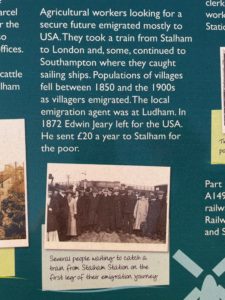 Finishing the day in Stalham, which is Not What It Used To Be due to emigration. Sid had been wondering what happened to the farm workers once the agricultural revolution improved yields and reduced the labour input. The panel shows a most romantic tale of people going to America, which would have been fiercely expensive. For most people the move was to either Norwich or Great Yarmouth. Many went to London and because the train to London was more expensive than the packet down the coast, despite the Parliament mandated workman’s rate of one penny per mile, many ended up at Limehouse rather than Liverpool Street Station. If I were a teenager in Stalham I would be looking at how to get to London, probably missing out the pause in Great Yarmouth though there is now no packet.
Finishing the day in Stalham, which is Not What It Used To Be due to emigration. Sid had been wondering what happened to the farm workers once the agricultural revolution improved yields and reduced the labour input. The panel shows a most romantic tale of people going to America, which would have been fiercely expensive. For most people the move was to either Norwich or Great Yarmouth. Many went to London and because the train to London was more expensive than the packet down the coast, despite the Parliament mandated workman’s rate of one penny per mile, many ended up at Limehouse rather than Liverpool Street Station. If I were a teenager in Stalham I would be looking at how to get to London, probably missing out the pause in Great Yarmouth though there is now no packet.
And finally two contenders for Conveyance of the Day, in a day of largely traffic-free walking.
The first is a hand cranked cart to run along the rails and can be easily lifted off the track. The second one is a Twike which zapped silently past us so it took Doris a little while to react and get a picture. This is an astonishingly expensive three wheeled hybrid of pedal and battery powered electric motor. £40,000, you’re havin’ a laugh, intcha? You could buy a proper car for that …. or ten Reliant Robin three wheelers …. or a mint Meyers Manx? Just sayin’



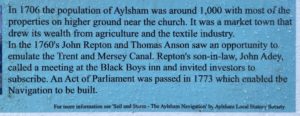
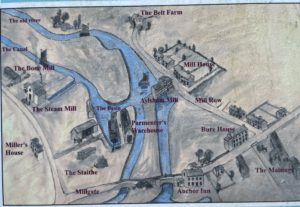
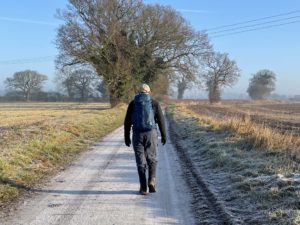
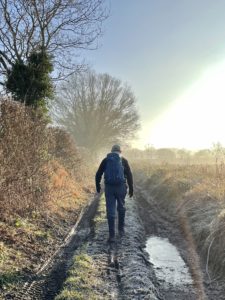
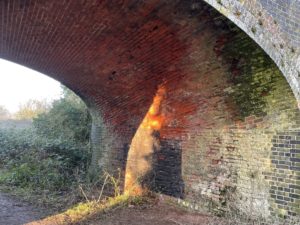

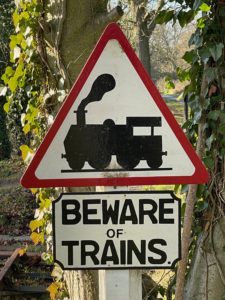
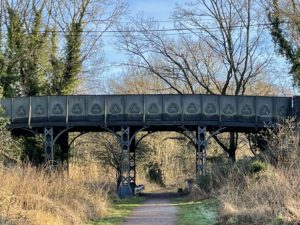

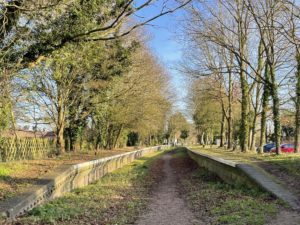

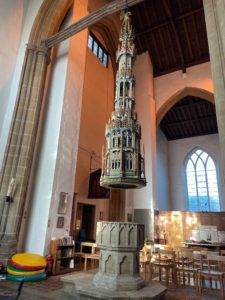
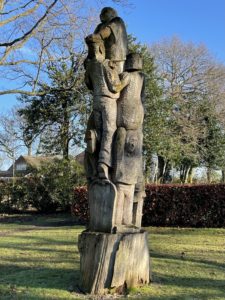
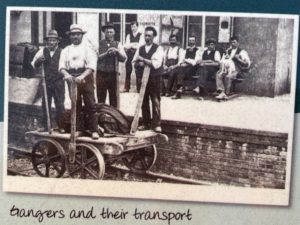

And a Meyers Manx has FOUR wheels! (And some even have sparkly paint…)